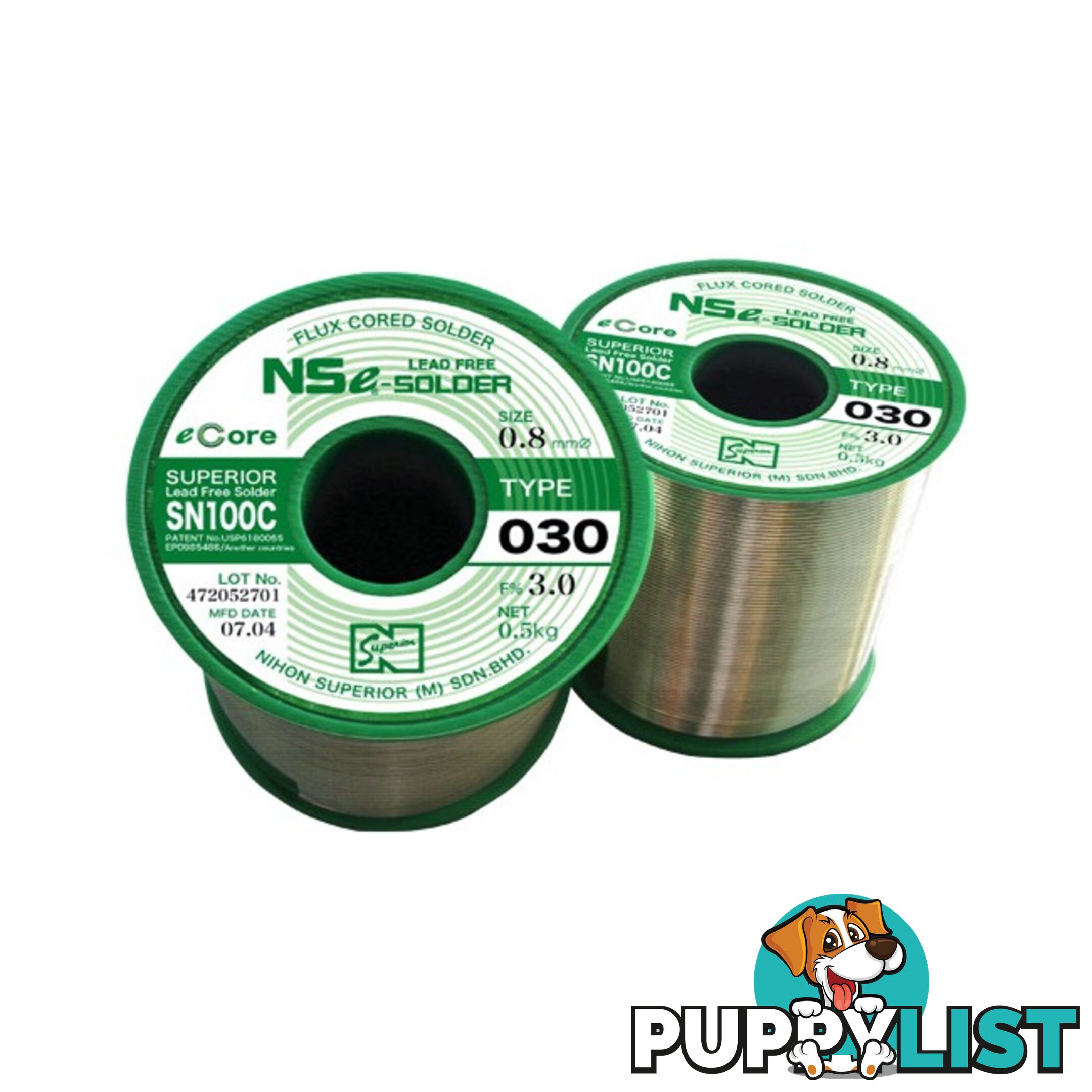LF2.0SN100C.5K 2.0MM LEAD FREE SOLDER 500G NIHON SUPERIOR SN100C
$121.00


DESCRIPTION
LEAD FREE SOLDER - NIHON SUPERIOR SN100CSuccessfully Tried and Tested
Leading electronics manufacturers throughout the world have used SN100C with outstanding results. To date, millionsof circuit boards have been assembled with the SN100C familyof solders in all types of products. Many of the devices soldered with SN100C already have been in use for several years.
Download the Nihon Flux-Cored Solder Wire product catalogue
Nihon Superior have developed SN100C 030 solder wire. One of its major points is that it is the only lead free alloy that looks and flows like normal tin/lead. SN100C is comprised of Sn/Cu/Ni Ge. (TIN, COPPER, NICKEL & GERMANIUM)
The flux-cored solder wire enables fast soldering with less carbonizing of soldering tip and less flux spatter providing greater productivity than existing products.
SN100C (030) lead-free flux-cored solder wire provides sharp spreading and good separation.
The high-reliability alloy suits fine-pitch application. It contributes to higher economic productivity with its improved efficiency over conventional products.
SN100C (030) also reduces bridging in soldering extra-fine coaxial harnessing in cell phones.
The alloy (Sn0.7Cu0.05Ni Ge) has a 0.1-mm diameter. SN100C (030) inhibits growth of the intermetallic layer and lowers copper erosion. Its highly ductile properties accommodate for strain on joints.
Key Benifits Include:
Shiny Lead Free Solder Joints
Less Tip Carbonizing
Less Flux Spatter
Less Cracking of Flux Residue
Fast Soldering
Fast Melting
Good Spread
Less Shrinkage Defect, Reduced Copper Erosion, and Stable Intermetallic Layer
Substantial cost advantage
FEATURES:
SN100C was developed by Nihon Superior in Japan and offers high-throughput and the lowest cost of ownership as compared to any other lead-free solder alloy.
Appearance: Besides the obvious benefits of being lead-free, this solder has a shiny appearance similar to tin/lead. This makes it easy to identify dry solder joints, which appear cloudy, a feature that other lead-free solders do not have.
Alloy Composition: Sn-Cu0.7-Ni0.05 Ge - Does not contain costly silver or bismuth.
Exact Melting Point of 227°C (True Eutectic)
Bridge-free and icicle-free soldering.
Smooth, bright, well-formed fillets, free of gross micro-cracks, irrespective of the cooling rate.
High Fluidity (Less Rework)
Low drossing alloy. - Dross rate equal or lower than tin-lead solder
Reliable joints (no reported failures in 7 years of field service).
Low copper pad erosion. - Does not erode copper from holes, pads and tracks
Low rate of copper leaching makes it easy to controlthe copper content of the solder bath
Does not require a nitrogen atmosphere.
Low aggressiveness to soldering equipment. - Lower aggressiveness to stainless steel and other solder pot materials as compared to tin-silver-copper alloys
Good through-hole penetration
Good topside fillet formation
Thermal fatigue resistance and creep strength betterthan tin-lead
Slow, even growth of the intermetallic layer at the solder/substrate interface
Also performs well in selective and dip soldering
Over 800 tons consumed each month worldwide.
SPECIFICATIONS:
Material Property
SN100C
Test method
Melting Temperature
Solidus ã227
Ramp ratefor different thermal analysis  20°/min
Liquidus ã227
S.G.
7.4
S.G. measuring apparatus 25°
Specific Heat
220
Estimated value
Thermal conductivity
64
Estimated value
Vickers Hardness
Slow cooling
16.1
Cast onto aluminum plate
Fast cooling
12.9
Cast onto insulating brick
Tensile strength
32
10mm/min. (25°)
Elongation
48
10mm/min. (25°)
Electrical resistance
0.13
For Terminal method (25°)
Â
Material Property
SN100C
Test method
Coefficient of                Thermal Expansion
30-80°
1.33x10-3
Conditions: Load: 10.0grams, sample ;Almina (20mm), Programmed temperature: 10°/min.
80-130°
1.38x10-3
130-180°
1.46x10-3
Spread Factor %
240°
77
JIS Z 3197
250°
77
260°
78
280°
78
Creep Strength (Time to Failure)
145°
>300 hours
145° load 1 kg
150°
>300 hours
150° load 1 kg
180°
>300 hours
180° load 1 kg
Wettability Seconds
Â
Ta
Tb
Fmax
Wetting Balance
0.3 X 3.5 X 25 mm
Ta = Zero cross time
Tb = Wetting time
Fmax = Max. wetting force
240°
1.0
4.53
0.159
250°
0.86
2.79
0.181
260°
0.47
1.46
0.186
270°
0.31
0.8
0.192
Copper erosion rate at 260°
~ 2 minutes
Time for complete erosion of 0.18mmΦ wire
Thermal shock
>1,000 cycles
-40/ 80° each 1hr
Electromigration
>1,000 hrs
40° 95%RH & 85° 85%RH
Whiskers
>1,000 hrs
50°
ADDITIONAL INFORMATION
- Price
- $121.00
- Condition
- New
- Delivers To
- Australia Wide
